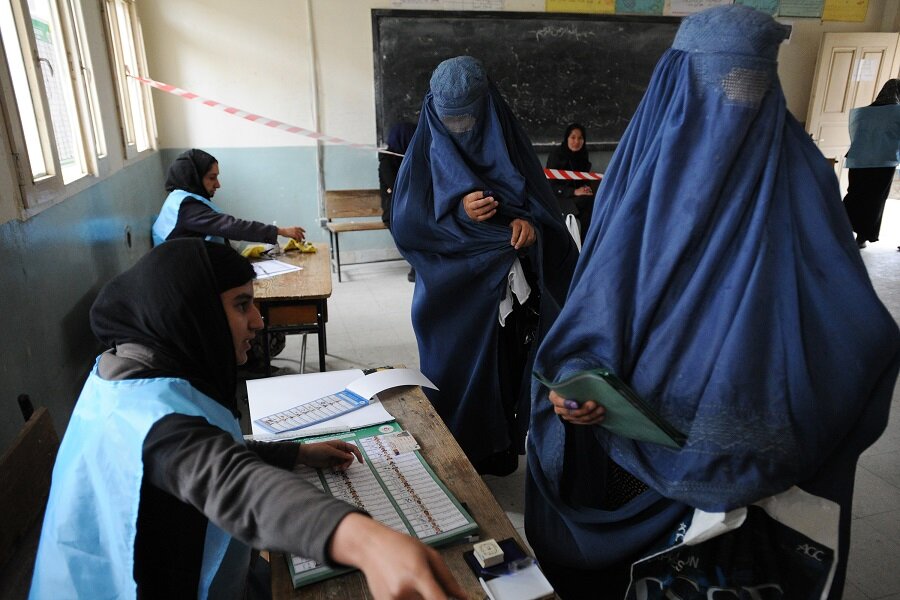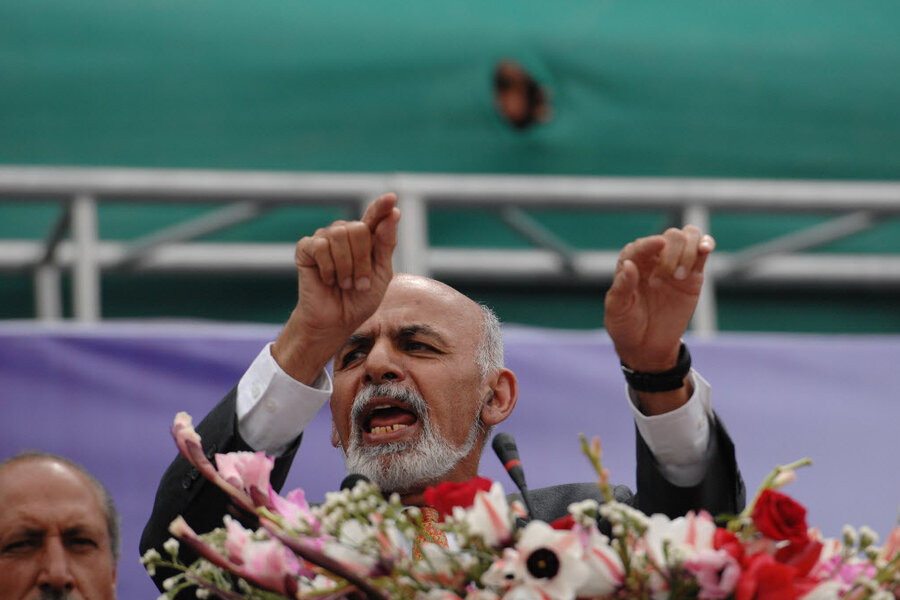Afghan election: High turnout to elect first new leader in a decade
| Kabul, Afghanistan
Afghan voters defied Taliban threats and cold wet weather today, turning out in large numbers at polling stations to shape Afghanistan’s first-ever democratic transition of power.
Blanketed by tight security and rain, Kabul witnessed virtually no violence and long lines at polling stations, despite a string of high-profile Taliban suicide attacks in the days before the vote. The Taliban vowed to disrupt elections, and kill or cut off the fingers of Afghans who took part.
There were multiple reports of violence in rural areas, and 211 voting centers out of 6,212 nationwide did not open due to security concerns. But in many cases Afghans surprised themselves – especially in urban centers – as ballots ran short in one-third of Afghan provinces and officials estimated a record high turnout of 60 percent of registered voters. Women voted in high numbers.
“It’s a historic day,” said shopkeeper Mohammad Shiri Sediqi, as he neared the end of a three-hour-long line on a muddy road in crowded southwest Kabul. “We have come to elect a person who will work for us in the future. We aren’t afraid of [Taliban] threats; that is for God to decide.”
President Hamid Karzai has led Afghanistan since shortly after US forces pushed the Taliban from power in late 2001, and he cannot run for reelection. Eight candidates are vying to replace him, and vowed that lessons had been learned from the fraud-laced 2009 vote.
“It’s historic, it’s transformative – democracy is getting rooted,” presidential candidate Ashraf Ghani Ahmadzai, one of the frontrunners, told the Monitor after casting his vote. The former finance minister and World Bank official said: “We believe in our people’s will, and it shall be done.”
Ultraviolet, not ultra-violence
Despite the rain, Kabul at times took on a carnival atmosphere, with pick-up games of soccer and cricket on mostly empty streets. Those Afghans who voted – dipping their fingers first in purple ink, and then getting a spray of invisible ink that could only be seen under the flashlights with ultra-violet lenses at each polling station – took part very seriously.
Security was also tight. Afghan intelligence officials announced before the polls opened that they had seized two rocket-propelled grenade launchers with 35 grenades, 28 AK-47 assault rifles, 31 police uniforms and 11 national police coats in a central district of Kabul. They had also quietly passed on warnings of five expected suicide attacks in the capital.
“People are not afraid because there is more security around here,” said Mohammad Zaman, a university student managing one polling station at a high school for girls. Desks and chairs had been placed outside, some carved with typical student graffiti like hearts and initials.
"Today security is very good and people come without fear,” said a 22-year-old observer for Ashraf Ghani at a polling station, whose finger nails were each painted with an Afghan flag.
“I voted! There comes a point where you aren’t afraid anymore,” shouted another woman holding up an ink-stained finger, as the car she was riding in drove past a police checkpoint. “Long live the Afghan police!” shouted a man out the window, raising his arm triumphantly as his car was pulled over at the same checkpoint.
But there were still fears of Taliban reprisals, even in Kabul.
“Don’t take photos,” warned Taj Mohammad, a young man with slicked back hair, as he stood in a line that snaked down a flooded alley to a main road. “It’s dangerous for the people. If the Taliban see it, they will attack us.”
“I am surprised at the numbers, because in the last election there were not many,” said Hassan Sadat, an office worker in the middle of the same muddy line. “Our government has developed. Is there hope? Yes.”
Fraud?
What could dash that hope is fraud and irregularities, which in 2009 left Afghanistan – a nation now renowned for the scale of its corruption – in political limbo for months.
“Of course everyone is afraid of fraud,” said Ahmad Yousaf Nuristani, chairman of Independent Election Commission, shortly after casting his vote. He called on Afghans to “prove to the enemies of Afghanistan that nothing can stop them.”
“Fraud is not a good thing, so we have adopted a number of mechanisms for fraud mitigation, and hope that we have no fraud this time, or very little,” said Mr. Nuristani. If not the best election in Afghan history, he said, “at least it is going to be much better than the one before.”
As Afghan voters lined up for their fifth election since 2001, they were given two pat-down searches, and sometimes scanned with metal-detector wands. Police checkpoints filled the capital. But election staff were clearly committed and some of the voting stations in Kabul were choked with 15 or more local candidate observers each.
Foreign poll observers from Democracy International have watched Afghan elections for a decade. The 250 Afghan women they saw this morning, lined up 15 minutes before polls opened, at the same high school as they had years earlier, was an instructive déjà vu.
“It was the exact number of ten years before, when the security situation was much better than now,” says observer Amandine Roche from France. “The conclusion is that no matter what, they go and vote. And this is pretty impressive. They are fearless, brave, and they dare to vote – it’s really democracy in action for me.”
As early as 9:30 am, this reporter saw voting officials traveling to central election offices to get more ballots, as voter numbers swelled. Many polling stations ran out of ballots, prompting reports of some angry voters who had waited for hours and finally gave up and went home.
In a bid to prevent that – and also prevent excessive movement of ballots during the day – Afghan election officials limited each station to 600 ballots, but included an extra set of 600 in every voting center, which might include a group of 6 or 8 voting stations.
“Large turnout here means that fraud is going to be diminished in the impact it can have,” says Democracy International observer J. Brian O’Day. “The last presidential election they threw out a million ballots, but that was nearly a quarter of the ballots that were cast. If you go back to 7 million ballots cast, [even] if there was that level of fraud…it’s going to have much less impact.”









